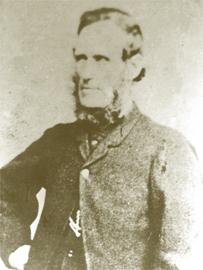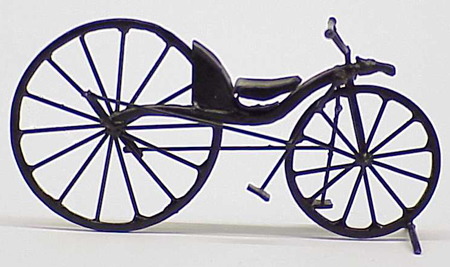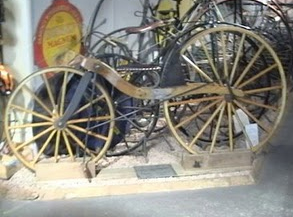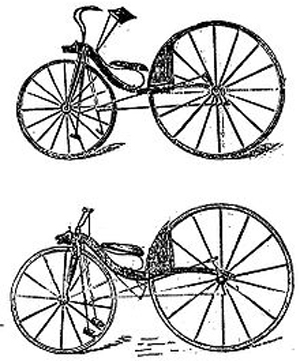Kirkpatrick McMillan
 Mon, May 9, 2011
Mon, May 9, 2011  Growing up in England and going to school there I was taught that a Scottish blacksmith named Kirkpatrick McMillan (1812 – 1878) invented the first pedal driven bicycle in 1839.
Growing up in England and going to school there I was taught that a Scottish blacksmith named Kirkpatrick McMillan (1812 – 1878) invented the first pedal driven bicycle in 1839.
The story goes that McMillan (Right.) saw a Hobby Horse being ridden near his home in Dumfries, Scotland; he decided to build himself one.
On completion he realized it would be an improvement if the machine had a means of propulsion so it could be ridden without putting his feet to the ground.
Cranks were attached to the rear wheel; movement was by connecting rods attached to pedals worked in a reciprocating motion by the rider’s feet. The exact same principle can be seen on a child’s pedal car to this day.

Today there are doubts cast on the claim that Kirkpatrick McMillan was the first to build a pedal driven bicycle. The problem was that McMillan never patented his invention, and it appears never even exploited the idea for profit.
Another Scottish blacksmith, Gavin Dalzell from Lesmahagow, copied the idea in 1846 and produced so many that for almost 50 years he was thought to be the inventor.
Then in the 1890s a wealthy corn trader named James Johnston, who just happened to be the nephew of Kirkpatrick McMillan, decided to throw a lot of money into proving that his uncle, now deceased, was indeed the inventor.
He unearthed all manner of neat stories, including one where in 1842 his uncle rode his bicycle 68 miles from Dumfries to Glasgow. While in the Gorbals District of Glasgow, McMillan colided with a young girl after she ran in front of his bicycle, injuring her slightly. He was fined five shillings.
A story was said to appear in a Glasgow newspaper reporting “An anonymous gentleman on a velocipede was fined five shillings.” Johnston claimed this was his uncle. However, there are doubts today that this incident actually happened or that the newspaper article even exists.
 This is the problem; James Johnston said a lot of things but never backed it up with documentation.
This is the problem; James Johnston said a lot of things but never backed it up with documentation.
He even had a blacksmith named Thomas McCall build a replica of his uncle’s machine for the 1896 Stanly Show.
Today this same replica can be seen in the Bicycle Museum at Drumlanrig Castle. (Above left.)
 Thomas McCall had himself been building these machines since 1869.
Thomas McCall had himself been building these machines since 1869.
The McMillan replica in the museum looks an awful lot like those attributed to Thomas McCall. (Picture right.)
Right down to the horses head carved on the front.
So is this a true replica of McMillan's original, or did McCall take Johnston’s money and then sell him one of his old stock models?
These would have been obsolete by the late 1800s, and McCall would have been more than happy to unload one of his old machines. Especially as he was 62 years old by then, maybe retired and could use the cash.
James Johnston may have been fully aware of this and knew that the Thomas McCall bicycle was not a true McMillan replica. This is only speculation on my part, but it was these attempts by Johnston to prove McMillan was the first by any means, or at any cost that now tends to cast doubt on the claim.
Was history re-written; dates fudged? It was certainly accepted as fact in Great Britian during the first half of the 20th. Century, and is still stated as such in many books and articles.
I like to keep an open mind. The point is even if it can’t be proved McMillan was the first, it probably can’t be disproved either. Kirkpatrick McMillan it seems was a modest man who never sought fame and fortune from his idea.
In spite of this his name will continue to have a place in history, along with the other names associated with the building of this type of machine; the ones I have mentioned here like Gavin Dalzell and Thomas McCall. Rightly so, because these men were all early pioneers of bicycle building.






















Reader Comments (3)
History of the bicycle is good to know about and see how it has evolved over the decades since the early 19th century. Here we are in the early 21st century and it still seems to be evolving around two wheels as the common factor.
The materials and methods used to make the bicycle have changed over the years and designs have come and gone. I think it is interesting to see how machines and tools evolve over time and then look back at what worked and what was not so good maybe. When something works well and seems to be a very good design for achieving the desired outcome, then that particular model of machine or tool becomes a standard and a benchmark in a way. There would be examples of this pinnacle of success in all sorts of non-motorized categories such as furniture, architecture, textiles and the like; a certain type of chair or building design or article of clothing just looks and feels right and suits the intended purpose so well that it becomes a classic design of that era.
I think the bicycle has gone through a number changes over time and hit the "sweet spot" a number of times over the decades just like the things mentioned above. There are certain types of bicycles that could be regarded as classics of an era within the categories of track bikes, road bikes, mountain bikes, etc. There seems to be more categories appearing as time goes on which I think will only be a good thing for cycling as a whole.
Certain materials and designs have also become the classic "building blocks" of choice, just like using certain types of wood for furniture, or building materials for homes and clothing, etc. These will change over time but there will always be a place for the classic material and design.
When the first pedal driven bicycle was created there weren't many categories of bicycle I would assume. Over time the bicycle has evolved like other objects of art and craft, and hopefully it will not end any time soon.
Interesting! The first "fixie"!
How did you put all the puzzle pieces together on this Dave?
Wow. I felt like i traveled back to the past by reading this. I am a very avid fan of bicycles and its great to know the history of my well loved ride.